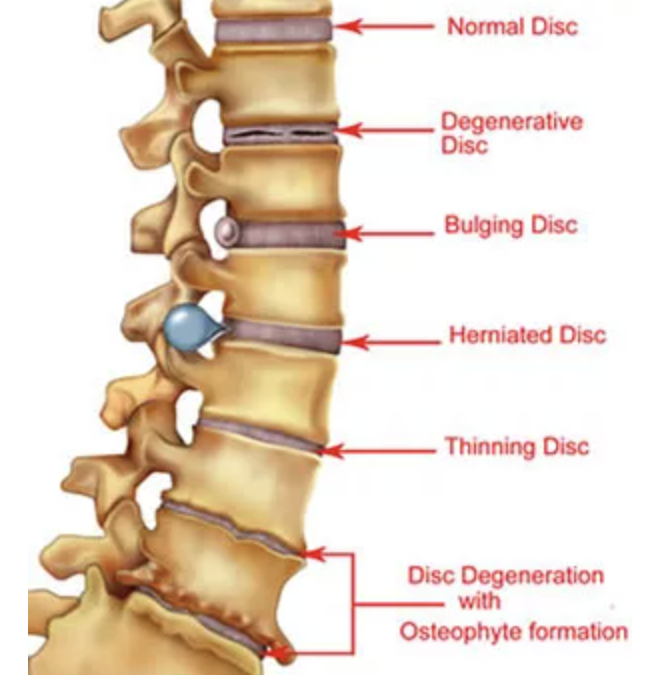A herniated disc also called spinal disc herniation is a very common condition in which there is a problem with a rubbery disc in between the spinal bones. Physical therapy plays a major role in the treatment of herniated discs. Your physical therapist will suggest the most effective and ideal treatment for you. This will speed up your recovery. Our innovative care strategies at Cypress Physical Therapy will help you find quick relief. To continue reading to learn more about herniated discs, their signs and symptoms, and the rehabilitation treatment for them.
Introduction to herniated disc
The bones that collectively form the spine are cushioned by discs. These discs are small and round with a strong exterior layer called the annulus that surrounds the nucleus. These discs are located between each bone in the spine and absorb shocks to protect the spinal bones. In spinal disc herniation, a part of the disc nucleus is pushed out of the disc of the annulus and into the spinal canal through a rupture in the annulus. Herniated discs are usually in the initial stages of degeneration. Now, the spinal canal only has a finite amount of space for the spinal nerves. These herniated discs on coming in contact with the spinal nerve and pressing against it produce pain which can be immense. Herniated discs can occur in any part of the spine. It is most common in the lower back and the neck. The area affected by pain is dependent on the location of a herniated disc. It can be caused by a single heavy injury or excessive strain in the spinal cord. As one age, the discs degenerate and weaken and even a low impact twist can also result in herniated discs. It mainly affects people between the ages of thirty and fifty. Men are more prone to this condition than women. Obesity, poor posture, smoking, repeated lifting, and participating in weight lifting sports can also result in a herniated disc.
-
Signs and symptoms of a herniated disc
The symptoms mainly depend on the position of the herniated disc and the size of the herniation. It also depends on the pressure exerted on the nearby nerves. Sometimes it can cause no pain at all. Other times the symptoms include:
- Aches and pain in the lower back, neck, arms, and back
- Difficulty or inability in turning or rotating the neck or back
- Tingling sensation or numbness in the neck, arms, hip, legs, shoulders, or feet
- The feeling of weakness in the arms and legs
- Hobbling while walking
- Intense pain when sitting, coughing, sneezing, and reaching things
- Difficulty in standing upright
- Being fixed in a position such as stooping forward or leaning to the side
- Trouble in getting up from the chair
- The problem is maintaining a single position for long such as sitting and standing because of pain
- Immense pain especially in the morning
This condition can be diagnosed through MRI scans, X-ray of the spine, computed tomography scan (CT scan), Myelogram, electromyogram, and nerve conduction studies. At the start, your doctor will recommend rest for a few days or several weeks. After that, it would also be treated by non-steroidal anti-inflammatory medication. Thereafter your doctor will recommend physical therapy to treat your condition. It is a non-surgical and effective way to treat herniated discs. Your physical therapist would conduct a detailed examination of your body taking the doctor’s recommendations into account and make a plan to devise a treatment especially for you. You will not require any surgery if your condition is treated by physical therapy.
2. Physical therapy treatment for spinal disc herniation
In almost all except the most critical cases, physical therapy has provided much better results than any surgical treatment. Your physical therapist will guide you on the exercises and treatments you can do at home. Through physiotherapy, you will be able to go back to your normal lifestyle and will be able to perform daily activities. The healing time is not fixed but changes can be noticed in two to eight weeks of the rehabilitation treatment if the right posture, pain reduction stretching, and strengthening program is implemented.
In one to two days following the diagnosis, the treatment will involve the following.
- Rest the affected area to avoid any strain on the concerned parts
- Avoid bed rest at all cost
- Being active around the house and going on short walks a few times per day. The movement will decrease pain and stiffness.
- Soothing the concerned area by applying ice packs for fifteen minutes every two hours
- Sitting on hard chairs. Soft couches must be avoided.
Some exercises that will follow includes:
- Exercises in water. It will help if other forms of exercise are painful.
- Weight training exercises. Must be done properly to avoid straining the back.
Exercises that involve lots of twisting and bending must not be performed. Proper guidance by the physical therapist must be taken. It will help you in reducing pain, improving posture, motion, flexibility, strength, and endurance.


